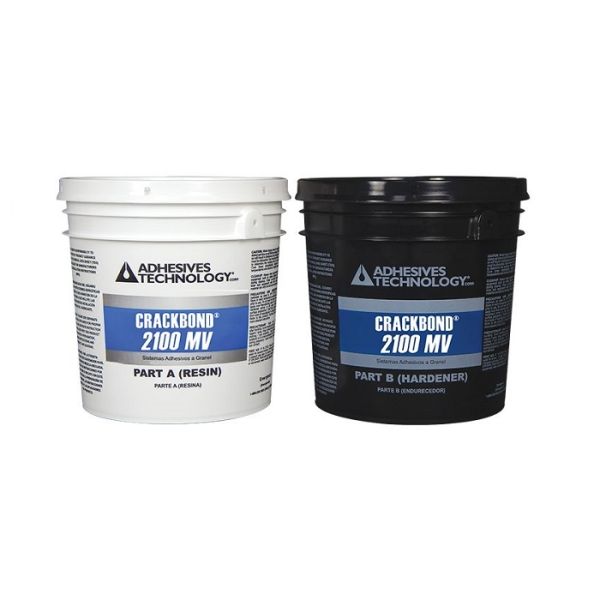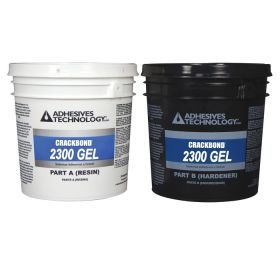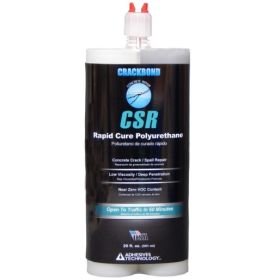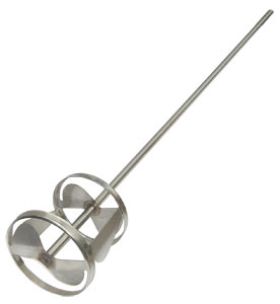Adhesives Technology Crackbond 2100MV BUG-2100
Two-component, high-strength epoxy adhesives that is ideal for bonding fresh to hardened concrete and perfect for use in a variety of repair projects. May be used in temperatures between 40 °F and 100 °F (4 °C and 38 °C).
- Moisture insensitive
- High modulus, self-leveling, medium viscosity
- Acceptable for use in USDA inspected facilities
CRACKBOND 2100 MV – 2 Gallon Kit – BUG-2100
CRACKBOND 2100 MV is a two-component, high-strength epoxy adhesive designed for structural bonding, grouting, and concrete repair. It meets ASTM C881 and AASHTO M235 standards and offers excellent chemical resistance, strong substrate bonding, and a self-leveling consistency. Ideal for horizontal crack injection, coating, spall repair, and bonding fresh to hardened concrete, this medium-viscosity system performs reliably even in damp conditions. It can be extended with sand for mortar or grout applications and is certified for use in drinking water system components under NSF/ANSI 61 and 372.
Key Features
- High-strength bonding of concrete to concrete or steel.
- Medium viscosity for easy placement and gravity-feed crack repair.
- Self-leveling consistency for horizontal surfaces.
- Excellent bond strength and chemical resistance.
- Can be extended with silica sand for grouting or mortar applications.
- Moisture-insensitive formulation cures in damp environments.
- Meets ASTM C881 Types I, II, IV & V; Grade 2, Class B & C.
- Certified to NSF/ANSI 61 and 372 for potable water systems.
Applications
- Bonding fresh concrete to hardened concrete or steel surfaces.
- Structural repair of spalls and delaminated areas.
- Horizontal gravity-feed crack injection.
- Coating and sealing of interior or exterior slabs.
- General-purpose bonding agent for repair projects.
- Use as a neat epoxy or extend with aggregate for patching.
Technical Specifications
| Mix Ratio | 1:1 by volume (Part A: Resin, Part B: Hardener) |
| Color (Mixed) | Gray |
| Compressive Strength (7 day) | 12,580 psi (ASTM D695) |
| Bond Strength (Hardened Concrete to Hardened Concrete) | 2,580 psi at 2 days; 3,350 psi at 14 days (ASTM C882) |
| Viscosity | 6,440 cP (at 75°F) |
| Pot Life | 37 minutes (1 gallon mix at 75°F) |
| Tack-Free Time | 3 hours 25 minutes |
| Application Temperature | 40°F to 100°F |
| Shelf Life | 24 months (unopened bulk); 12 months (cartridge) |
| Certifications | NSF/ANSI 61 & 372, USDA Acceptable |
Frequently Asked Questions
Can CRACKBOND 2100 MV be extended with sand for repair applications?
Yes, it can be extended using a 1:1 sand-to-epoxy ratio to produce a flowable grout or repair mortar for spall repair and patching.
Is CRACKBOND 2100 MV safe for use in drinking water applications?
Yes. It is certified to NSF/ANSI 61 and 372, making it suitable for potable water system components.
What is the working temperature range for installation?
CRACKBOND 2100 MV can be applied in ambient conditions between 40°F and 100°F.
What is the best way to apply this epoxy as a coating or bonding agent?
Use a roller or brush to apply evenly to prepared concrete or steel surfaces. Fresh concrete should be placed while the epoxy is still tacky.
What is the difference between CRACKBOND 2100 MV and 2100 MV-LPL?
The LPL version has a longer pot life and working time, which is beneficial in warm temperatures or large-volume applications.













Please complete your information below to login.